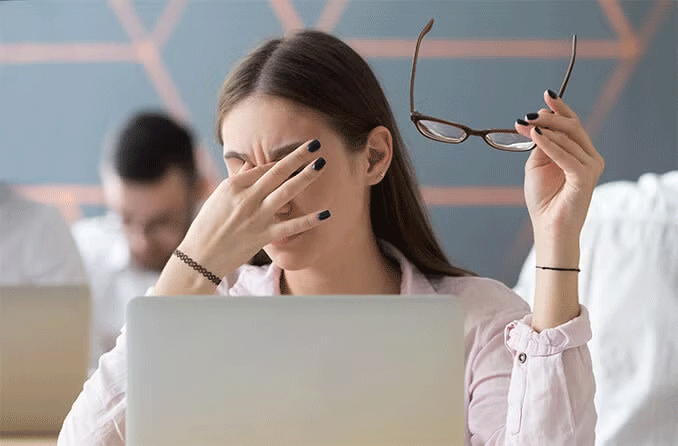Why you shouldn't use Dark Mode on your phone?
Most of the devices we use today, from smartphones to laptops, allow for Dark Mode. While proponents claim it can reduce eye strain and save battery life, the setting may not always be the best option for everyone.
Dark Mode may not significantly reduce eye strain
 Why you shouldn't use Dark Mode on your phone? Picture 1
Why you shouldn't use Dark Mode on your phone? Picture 1
Many people believe that putting their phones and individual apps into Dark Mode will instantly reduce eye strain. There's no doubt that eye strain is a common problem, especially since most of us spend a large portion of our day staring at screens.
The idea that a simple display setting change on your phone can be a quick fix is certainly appealing but also overly simplistic, to put it mildly.
While Dark Mode can help reduce eye strain in low-light conditions where your phone's bright screen is the only source of light, it's not as effective in brightly lit environments. In fact, using Dark Mode on a sunny day actually forces your eyes to work harder to focus, which can lead to more eye strain.
If you're concerned about eye strain, using Dark Mode in the evening (when the lights are typically dimmer) can help. During the day, however, it's best to default to light mode. Also, keep your device at or below eye level to avoid eye strain.
How does Dark Mode affect readability?
 Why you shouldn't use Dark Mode on your phone? Picture 2
Why you shouldn't use Dark Mode on your phone? Picture 2
Think reading is easier with Dark Mode on? Probably not. Think about it — we've evolved to see dark objects on lighter backgrounds. This means your phone's white background doesn't affect your ability to read.
Researchers in the Journal of the Human Factors and Ergonomics Society found in one study that using light mode improves the ability to perceive details. Similarly, another study found that light mode makes text easier to read than dark mode.
It's also worth noting that people with astigmatism may have difficulty reading text in Dark Mode due to the halo effect, which makes light text on a dark background look blurry.
Since one in three people suffer from astigmatism, a significant portion of the general population may experience less than ideal reading conditions when using Dark Mode on their devices.
Not always saving battery
 Why you shouldn't use Dark Mode on your phone? Picture 3
Why you shouldn't use Dark Mode on your phone? Picture 3
One of the main advantages of Dark Mode is that it can help save your device's battery life. Considering how much we rely on our phones for everything from drafting work emails to listening to the latest podcast, it's easy to see why anything that claims to extend battery life gets a lot of traction.
However, while Dark Mode can indeed help save battery, this benefit only applies to phones with OLED and AMOLED displays.
If you have a device with an LCD display, switching to Dark Mode won't affect battery life, so before making any changes, check to see if your phone has an AMOLED or LCD display.
Even with devices with OLED and AMOLED displays, you may only notice a significant difference if your brightness is set to 100% before. On the other hand, if your phone's brightness is set to 30% to 40%, as it is by default, the researchers found that switching to Dark Mode only increased battery life by up to 9% on average.
These savings are so small that most users won't notice a difference when switching to Dark Mode. In fact, there are a number of other tried-and-true tips that can help extend battery life on your Android phone or iPhone. These strategies may be more effective if you're looking to increase your battery life.
Does not reduce distraction
 Why you shouldn't use Dark Mode on your phone? Picture 4
Why you shouldn't use Dark Mode on your phone? Picture 4
Unless you use a specific Android app to help you avoid distractions, switching from light mode to dark mode won't make a noticeable difference. All dark mode does is change the visual theme of your phone, but it doesn't turn off notifications or make it easier to multitask.
If you want to maximize your productivity without installing apps, there are certain Android features that can help reduce distractions. For example, you can use Focus Mode or Do Not Disturb mode to work without interruptions. It's better to try these settings than to expect Dark Mode to significantly reduce distractions.
When should you use Dark Mode?
All of this doesn't mean you should never use Dark Mode on your phone or other devices. If you're in a dimly lit room, turning on Dark Mode on your device can reduce glare and make text easier to read. Dimmer screen settings, whether Dark Mode or Night Mode, can also be helpful if you're sensitive to bright light.
Also, if you're concerned about your device's battery life and have a phone with an OLED or AMOLED display, switch to Dark Mode to see if it makes a noticeable difference. Since you can always switch back, there's no harm in experimenting.
You should read it
- How to use Mojave's Dark Mode on Mac right now?
- What is the dark mode (dark mode)? Benefits and harms that dark background mode brings?
- How to enable Dark Mode in Ubuntu 20.04 LTS
- How to turn on Dark Mode on Google Keep and Google Calendar
- Why doesn't Dark Mode help improve battery life on your laptop?
- Experience the main Dark Mode mode on Android 9 Pie
- How to turn on Dark Mode on Chrome
- How to activate Dark Mode on Windows 10?
- Android Q will have Dark Mode (Dark Mode) throughout the system
- How to turn on Dark Mode for Firefox
- How to turn on the dark background interface on iPhone applications
- How to enable Dark Mode for Gmail
May be interested

11 Creative Ways to Use Microsoft Word

How to enable Notification Cooldown on Android 16

12 Most Tweakable Developer Options on Android

Brave Search will now let users 'downvote' bad website results

OpenAI Announces Operator, an AI Agent That Automatically Performs Tasks on User's Behalf

Signs You May Have 'Brain Rot'






 How to use Mojave's Dark Mode on Mac right now?
How to use Mojave's Dark Mode on Mac right now? What is the dark mode (dark mode)? Benefits and harms that dark background mode brings?
What is the dark mode (dark mode)? Benefits and harms that dark background mode brings? How to enable Dark Mode in Ubuntu 20.04 LTS
How to enable Dark Mode in Ubuntu 20.04 LTS How to turn on Dark Mode on Google Keep and Google Calendar
How to turn on Dark Mode on Google Keep and Google Calendar Why doesn't Dark Mode help improve battery life on your laptop?
Why doesn't Dark Mode help improve battery life on your laptop? Experience the main Dark Mode mode on Android 9 Pie
Experience the main Dark Mode mode on Android 9 Pie